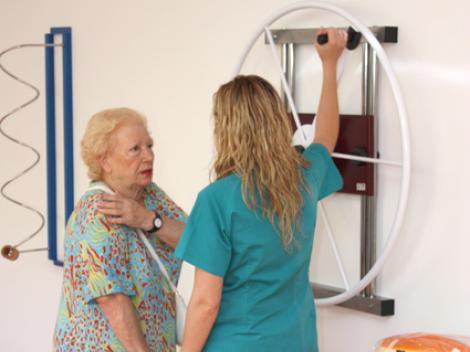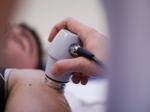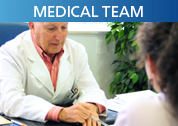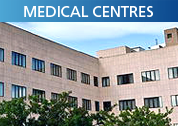


Shoulder
Information about shoulder rehabilitación
The shoulder rehabilitation starts after the patient is discharged from the clinic or hospital where they had their operation.
During the post-operative shoulder rehabilitation period it is important to do rehabilitation exercises in which full and gradual rehabilitation depends largely on the patient's persistence and continuity with the exercise programme.
Patients are advised to initially do several short exercise sessions a day (no more than 10-15 minutes each) with isometric arm muscle exercises and passive mobilisation of the affected shoulder.
Phase 1
- Assessment of surgical incisions or wound, allowing the tissue to heal properly and preventing adhesions or other complications.
- Magnet therapy and/or pulsed ultrasound to reduce initial inflammation and encourage tendon repair.
- Pendular exercises: flexion and rotation.
- Passive shoulder exercises: flexion, abduction, external rotation, internal shoulder rotation, elbow flexion Progression of passive movement arcs depending on how well they are tolerated by the patient.
- Cryotherapy: icing for 15 to 20 minutes Using ice at least 6-7 times a day.
- Continuing with mobility exercises for elbow and hand (and grasping exercises).
- Active assisted mobility exercises (with a bar).
- Isometric exercises.
- Patients are shown how to place the affected shoulder correctly, using an arm or shoulder sling.
- Patients are also shown how to place the affected shoulder while they are in bed at night.
Phase 2
- Passive mobility.
- Active assisted mobility as tolerated.
- Continuing with isometric contractions.
- Continue with use of cryotherapy if required, especially at the end of the physiotherapy session.
- Start strengthening exercises for internal and external rotators.
- Start manual resistance exercises for external rotation of the shoulder blade while the patient is lying down.
- Start prone rowing exercises with the shoulder in a neutral position.
- Start isotonic elbow exercises.
- Continue using pulsed ultrasound.
- Heat can be used at this stage (infra-red) before doing mobility exercises.
Phase 3
- Continue with elongations and mobility exercises (ensuring a full arc of movement).
- Continue with dynamic stability exercises.
- Progress to the strengthening programme.
- Pulley exercises for internal and external rotation.
- External rotation while the patient is lying on their side.
- Side lifts (active mobility only).
- Full mobility of the shoulder blade.
- Prone rowing exercises.
- Prone horizontal abduction.
- Progressing to the independent programme of exercises at home (basic shoulder exercises).
Maintenance and Practical Advice
- Continue with the basic shoulder exercises (at least 4 times a week). Continue with elongations if movement is still limited.
- The physiotherapy unit provides patients who have had shoulder operations with a series of exercises to do at home, along with explanatory diagrams for the patient who has been shoulder treated.
The importance of immediate rehabilitation
- Thorough rehabilitation is essential following an operation of this kind. Rehabilitation should start as soon as possible and patients should try to avoid travelling, making sudden movements or lifting heavy objects in the first few days. Before patients return to their home country, we advise them to undertake at least 8 days of rehabilitation at our Casaverde rehabilitation centre.
- An early start enables muscle tone to be improved; muscles around the affected area become gradually stronger and more powerful as they are worked consistently during treatment. Strong muscles reduce the risk of falls and complications.
- Early rehabilitation leads to a faster recovery of movement in the affected joint and reduces the pain and/or soreness that may develop following an operation.
- Early rehabilitation improves trophism (nourishment of the tissues surrounding the surgery site) and encourages the wound to heal correctly.
- Rehabilitation enables mobility to be recovered faster, enabling patients to walk again with the assistance and guidance of the care team as they learn to re-programme their walking patterns.



